Information for the community
Considered the “best gymnast in Chile’s history” according to international specialists, he was the first of his country to achieve medals in the Pan American Games and World Championships. He registered the “Gonzalez” Jump in the Floor Exercises in 2003. With his participation in London 2012 Olympic Games, he became the first Chilean to participate in an Olympic gymnastics event and to qualify for an Olympic final –particularly in the events for Vault and Floor Exercise– obtaining the fourth place in both competitions. He qualified once more for the Vault finals in Rio de Janeiro 2016, finishing in seventh place. In the 2019 Pan American Games, he achieved the gold medal in the floor exercise event. In April 2017, he was chosen president of the Chilean Gymnastics Federation.
With the inspiration of his shape and his sports achievements, in 2016 a gymnastics school is created that carries his name and aims to contribute with the development of national sport. This centre has two branches, one located in Las Condes in the Iván Zamorano Sports City and the other one is located in Llanquihue, a location in the south of Chile.
Furthermore, González is a member of the sports plan Chilean Association of Olympic Athletes (ADO Chile in Spanish) and has been able to participate in the finals of the World Gymnastics Championship circuit in seventeen occasions, winning nine medals in said Championships.
Go back to sports







